| return to main uk 2001 page | return to home page | contact me |
greyfriars kirkyard
edinburgh |
|
|
|
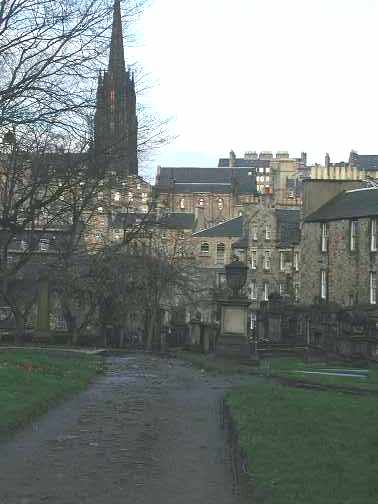 Greyfriars Kirk, dating from 1620, was the first church built in Edinburgh after the Reformation. You may have heard of Greyfriars Bobby, the most famous dog in Scotland. If you haven't, throw the name into Google. I'm not going to re-tell the story here when lots of other people have done it already. This shot is looking through the kirkyard, over the walls to the north and into part of the city. Edinburgh is very hilly, and this picture just doesn't do justice to the feel of how packed in these houses and buildings are. Greyfriars Kirk, dating from 1620, was the first church built in Edinburgh after the Reformation. You may have heard of Greyfriars Bobby, the most famous dog in Scotland. If you haven't, throw the name into Google. I'm not going to re-tell the story here when lots of other people have done it already. This shot is looking through the kirkyard, over the walls to the north and into part of the city. Edinburgh is very hilly, and this picture just doesn't do justice to the feel of how packed in these houses and buildings are. |
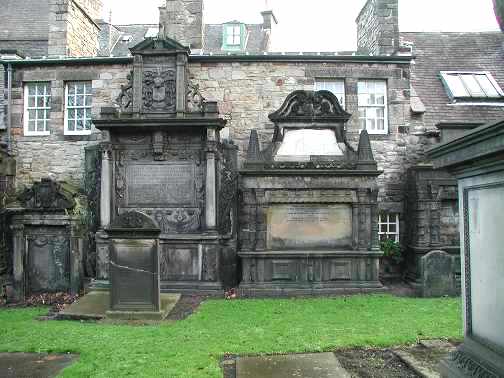 The city surrounds the kirk and snugs up to the walls, as you can see in this picture of some gravestones against the kirkyard wall. The city surrounds the kirk and snugs up to the walls, as you can see in this picture of some gravestones against the kirkyard wall. |
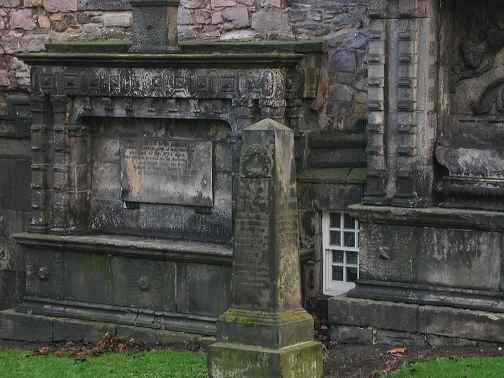 A closeup of the former picture. Would you like to have this view from your window? (Well, I would, but then again I think old graveyards are cool. I'm just weird that way.) A closeup of the former picture. Would you like to have this view from your window? (Well, I would, but then again I think old graveyards are cool. I'm just weird that way.) |
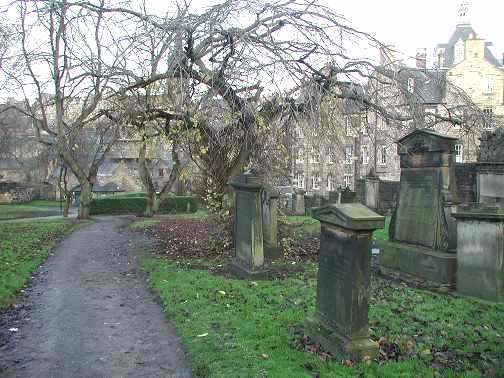 A very cool tree in the kirkyard. A very cool tree in the kirkyard. |
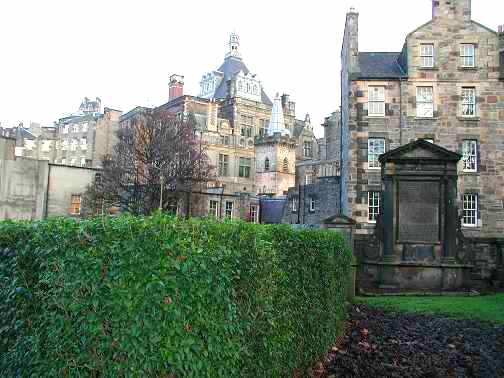 Another shot of city right next to the kirkyard. The hedge there was planted in a triangle shape, and had no way into the center as far as I could tell except by going over. I have no idea what its function or purpose is, since there were no gravestones inside it, and no sign to explain. Just one of those mysteries. Another shot of city right next to the kirkyard. The hedge there was planted in a triangle shape, and had no way into the center as far as I could tell except by going over. I have no idea what its function or purpose is, since there were no gravestones inside it, and no sign to explain. Just one of those mysteries. |
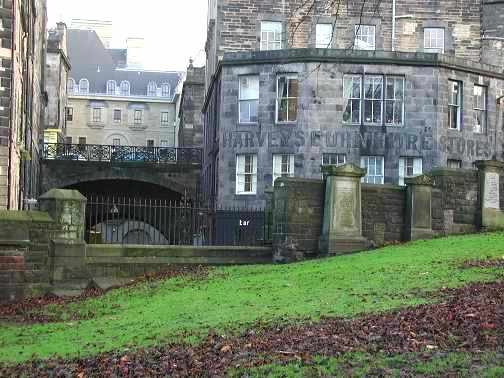 It doesn't quite look it, but there's a street between the kirkyard wall and the building there. It doesn't quite look it, but there's a street between the kirkyard wall and the building there. |
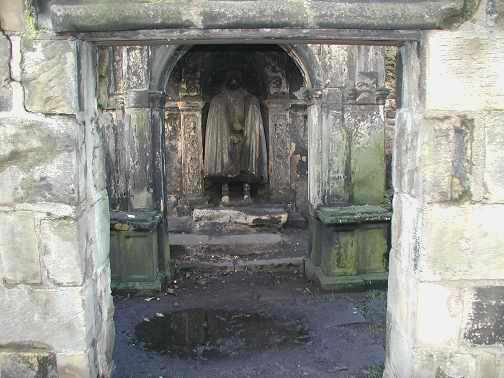 A dramatic tomb. A dramatic tomb. |
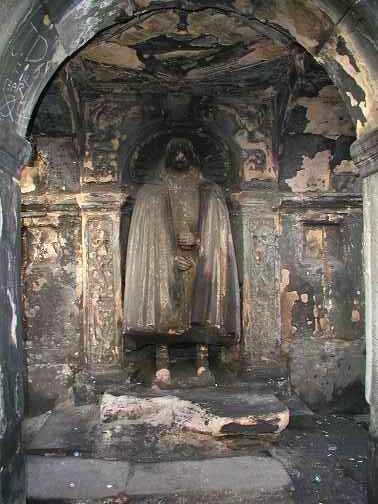 Closer view of the central figure. Closer view of the central figure. |
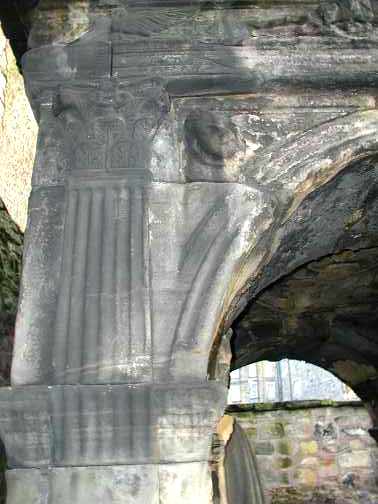 Part of the archway on the left side of the tomb. Part of the archway on the left side of the tomb. |
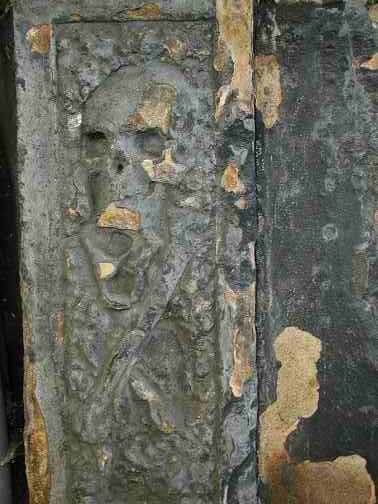 Sculptural detail of the tomb - skull. Sculptural detail of the tomb - skull. |
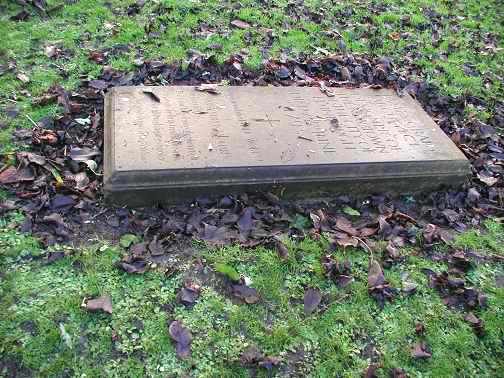 Gravestone marking the final resting place of James Craig, the man who designed the city plan for the Edinburgh Georgian New Town. Gravestone marking the final resting place of James Craig, the man who designed the city plan for the Edinburgh Georgian New Town. |
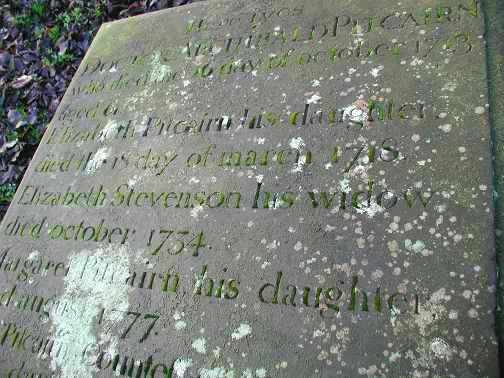 Closeup of a grave marker showing moss growing in the carved-out words of the stone. Mom and I figured that moisture must collect in the lhollows of the letters, which encourages the moss growth. Very cool effect. Closeup of a grave marker showing moss growing in the carved-out words of the stone. Mom and I figured that moisture must collect in the lhollows of the letters, which encourages the moss growth. Very cool effect. |
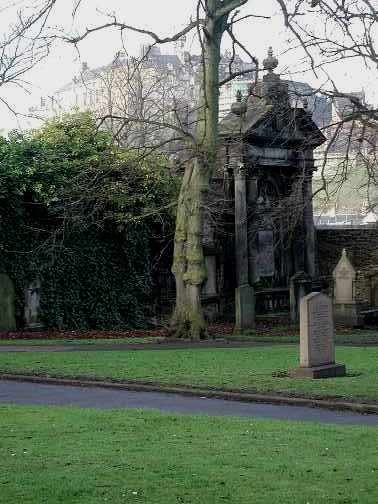 Edinburgh Castle looming in the background over the city. Edinburgh Castle looming in the background over the city. |
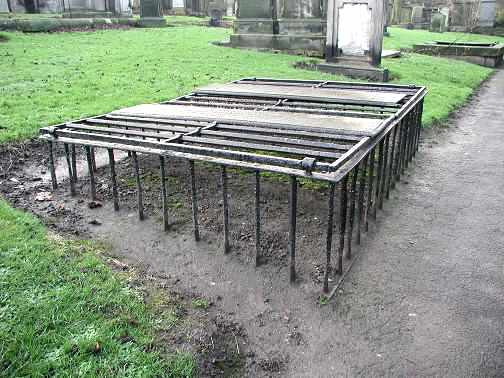 What I *think* this is, is a cage designed to keep resurrectionists from getting to a grave. During the 18th and early 19th centuries, Edinburgh medical schools, which were famous then and now as teaching hospitals, had a problem with teaching anatomy. It was illegal to dissect bodies except for those of executed criminals, which led to a lively trade in black-market corpses. Graverobbers, known as 'resurrectionists,' would dig up new graves and sell the bodies to the medical schools (do a websearch for 'Burke and Hare' to read about the most famous of them), which led to families hiring watchmen to stand guard over the new graves for a couple of weeks after each burial. I expect this cage might be to keep the bodies beneath from being stolen - the dates on the graves were from the right era. What I *think* this is, is a cage designed to keep resurrectionists from getting to a grave. During the 18th and early 19th centuries, Edinburgh medical schools, which were famous then and now as teaching hospitals, had a problem with teaching anatomy. It was illegal to dissect bodies except for those of executed criminals, which led to a lively trade in black-market corpses. Graverobbers, known as 'resurrectionists,' would dig up new graves and sell the bodies to the medical schools (do a websearch for 'Burke and Hare' to read about the most famous of them), which led to families hiring watchmen to stand guard over the new graves for a couple of weeks after each burial. I expect this cage might be to keep the bodies beneath from being stolen - the dates on the graves were from the right era. |
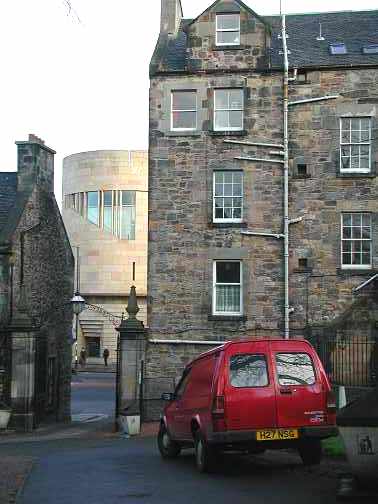 Edinburgh wasn't always dark and gray. Most of the buildings are constructed from local limestone, which reacted with exposure to wood and coal smoke from eras past to form magnesium ... erm, sulfate? calcite? I've forgotten exactly what it was, but rest assured the resulting compound makes that dark color you see on the buildings in the foreground of the picture. You can see what new limestone looks like on the facade of the new Edinburgh Museum in the background. Edinburgh wasn't always dark and gray. Most of the buildings are constructed from local limestone, which reacted with exposure to wood and coal smoke from eras past to form magnesium ... erm, sulfate? calcite? I've forgotten exactly what it was, but rest assured the resulting compound makes that dark color you see on the buildings in the foreground of the picture. You can see what new limestone looks like on the facade of the new Edinburgh Museum in the background. |
|
|
| return to main uk 2001 page | return to home page | contact me |
 Greyfriars Kirk, dating from 1620, was the first church built in Edinburgh after the Reformation. You may have heard of Greyfriars Bobby, the most famous dog in Scotland. If you haven't, throw the name into Google. I'm not going to re-tell the story here when lots of other people have done it already. This shot is looking through the kirkyard, over the walls to the north and into part of the city. Edinburgh is very hilly, and this picture just doesn't do justice to the feel of how packed in these houses and buildings are.
Greyfriars Kirk, dating from 1620, was the first church built in Edinburgh after the Reformation. You may have heard of Greyfriars Bobby, the most famous dog in Scotland. If you haven't, throw the name into Google. I'm not going to re-tell the story here when lots of other people have done it already. This shot is looking through the kirkyard, over the walls to the north and into part of the city. Edinburgh is very hilly, and this picture just doesn't do justice to the feel of how packed in these houses and buildings are.  The city surrounds the kirk and snugs up to the walls, as you can see in this picture of some gravestones against the kirkyard wall.
The city surrounds the kirk and snugs up to the walls, as you can see in this picture of some gravestones against the kirkyard wall. A closeup of the former picture. Would you like to have this view from your window? (Well, I would, but then again I think old graveyards are cool. I'm just weird that way.)
A closeup of the former picture. Would you like to have this view from your window? (Well, I would, but then again I think old graveyards are cool. I'm just weird that way.) A very cool tree in the kirkyard.
A very cool tree in the kirkyard. Another shot of city right next to the kirkyard. The hedge there was planted in a triangle shape, and had no way into the center as far as I could tell except by going over. I have no idea what its function or purpose is, since there were no gravestones inside it, and no sign to explain. Just one of those mysteries.
Another shot of city right next to the kirkyard. The hedge there was planted in a triangle shape, and had no way into the center as far as I could tell except by going over. I have no idea what its function or purpose is, since there were no gravestones inside it, and no sign to explain. Just one of those mysteries. It doesn't quite look it, but there's a street between the kirkyard wall and the building there.
It doesn't quite look it, but there's a street between the kirkyard wall and the building there. A dramatic tomb.
A dramatic tomb. Closer view of the central figure.
Closer view of the central figure. Part of the archway on the left side of the tomb.
Part of the archway on the left side of the tomb. Sculptural detail of the tomb - skull.
Sculptural detail of the tomb - skull. Gravestone marking the final resting place of James Craig, the man who designed the city plan for the Edinburgh Georgian New Town.
Gravestone marking the final resting place of James Craig, the man who designed the city plan for the Edinburgh Georgian New Town. Closeup of a grave marker showing moss growing in the carved-out words of the stone. Mom and I figured that moisture must collect in the lhollows of the letters, which encourages the moss growth. Very cool effect.
Closeup of a grave marker showing moss growing in the carved-out words of the stone. Mom and I figured that moisture must collect in the lhollows of the letters, which encourages the moss growth. Very cool effect. Edinburgh Castle looming in the background over the city.
Edinburgh Castle looming in the background over the city. What I *think* this is, is a cage designed to keep resurrectionists from getting to a grave. During the 18th and early 19th centuries, Edinburgh medical schools, which were famous then and now as teaching hospitals, had a problem with teaching anatomy. It was illegal to dissect bodies except for those of executed criminals, which led to a lively trade in black-market corpses. Graverobbers, known as 'resurrectionists,' would dig up new graves and sell the bodies to the medical schools (do a websearch for 'Burke and Hare' to read about the most famous of them), which led to families hiring watchmen to stand guard over the new graves for a couple of weeks after each burial. I expect this cage might be to keep the bodies beneath from being stolen - the dates on the graves were from the right era.
What I *think* this is, is a cage designed to keep resurrectionists from getting to a grave. During the 18th and early 19th centuries, Edinburgh medical schools, which were famous then and now as teaching hospitals, had a problem with teaching anatomy. It was illegal to dissect bodies except for those of executed criminals, which led to a lively trade in black-market corpses. Graverobbers, known as 'resurrectionists,' would dig up new graves and sell the bodies to the medical schools (do a websearch for 'Burke and Hare' to read about the most famous of them), which led to families hiring watchmen to stand guard over the new graves for a couple of weeks after each burial. I expect this cage might be to keep the bodies beneath from being stolen - the dates on the graves were from the right era. Edinburgh wasn't always dark and gray. Most of the buildings are constructed from local limestone, which reacted with exposure to wood and coal smoke from eras past to form magnesium ... erm, sulfate? calcite? I've forgotten exactly what it was, but rest assured the resulting compound makes that dark color you see on the buildings in the foreground of the picture. You can see what new limestone looks like on the facade of the new Edinburgh Museum in the background.
Edinburgh wasn't always dark and gray. Most of the buildings are constructed from local limestone, which reacted with exposure to wood and coal smoke from eras past to form magnesium ... erm, sulfate? calcite? I've forgotten exactly what it was, but rest assured the resulting compound makes that dark color you see on the buildings in the foreground of the picture. You can see what new limestone looks like on the facade of the new Edinburgh Museum in the background.